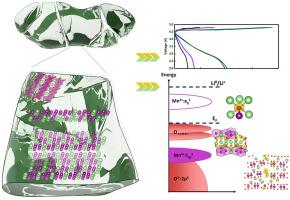Nano Energy ( IF 17.6 ) Pub Date : 2021-01-21 , DOI: 10.1016/j.nanoen.2021.105812 Haoxiang Zhuo , Yang Liu , Zhenyao Wang , Anbang Zhang , Zhao Li , Zhimin Ren , Xianghuan Liu , Haoyang Peng , Ligen Wang , Jingmin Shi , Xueyi Sun , Shigang Lu , Dingguo Xia , Weidong Zhuang

|
Li-rich and Mn-based oxides (LRMO) have been an obvious choice of high specific energy batteries owing to their unique anion redox behavior based on the main component Li2MnO3. However, there are still electrochemical behaviors that cannot perfectly match the theoretical structure. So far, most theoretical research on LRMO has been carried out around the ideal Li2MnO3 structure. Nevertheless, there are a great number of non-ideal local configurations in the pristine materials under the case of practical situations. Herein, the ubiquitous complex local structures (defect-like) in the interior of Li2MnO3 particle, some of which have not been observed in the past, are directly presented through the atomic-level observation. We summarized these structures and proposed for the first time the great influence of these local structures on the electrochemical and the oxygen redox behavior of LRMO by combining observation, DFT calculation, XAS, XPS and electrochemical experiments. These micro-structures have been roughly divided into four categories by the advanced AC-STEM, including the so-called stacking faults caused by the slip of the adjacent TM layer, the local multi-Li or multi-Mn arrangement due to the combination of different stacking type along a–b plane, the expansion of the interlayer spacing, and even the distribution of polycrystalline domains, of which the second and third configurations were observed for the first time. These types of local structures dominate the electrochemical reaction of electrodes in some aspects by improving the activity of oxygen non-bonding 2p states, along with the improvement of (de)intercalation ability for Li ions in the bulk through reducing the energy barrier, and they are even one of the sources of voltage hysteresis by affecting the energy level distribution of oxygen unoccupied 2p states after delithiation. This research has perfected a more comprehensive and practical understanding of LRMO under the case of practical situations, laying a key foundation for the further modification and application of LRMO cathode materials.
中文翻译:

从局部结构看富锂和锰基氧化物材料的反应机理和阴离子氧化还原行为
富锂和锰基氧化物(LRMO)由于其基于主要成分Li 2 MnO 3的独特阴离子氧化还原行为,已经成为高比能量电池的明显选择。但是,仍然存在电化学行为,不能完全符合理论结构。到目前为止,关于LRMO的大多数理论研究都是围绕理想的Li 2 MnO 3结构进行的。然而,在实际情况下,原始材料中仍存在大量非理想的局部构造。在这里,Li 2 MnO 3内部普遍存在复杂的局部结构(缺陷状)通过原子级观测可以直接呈现过去从未观察到的某些粒子。我们总结了这些结构,并首次结合观察,DFT计算,XAS,XPS和电化学实验,提出了这些局部结构对LRMO的电化学和氧还原行为的重大影响。先进的AC-STEM将这些微结构大致分为四类,包括由相邻TM层的滑移,局部多Li或多Mn排列(由于以下原因的结合)引起的所谓堆垛层错沿a-b平面的不同堆积类型,层间间距的扩展,甚至是多晶畴的分布,其中首次观察到第二和第三种构型。在某些方面,这些类型的局部结构通过改善氧非键2p态的活性以及通过减小能垒来提高整体锂离子的(脱)嵌入能力,主导了电极的电化学反应。通过影响脱锂后未占据的2p态氧的能级分布,它们甚至是电压滞后的来源之一。本研究在实际情况下完善了对LRMO的更全面和实用的理解,为进一步改性和应用LRMO阴极材料奠定了关键基础。锂离子通过降低能垒提高了锂离子的(脱)嵌入能力,甚至通过影响脱锂后2p态氧的能级分布,甚至成为电压滞后的来源之一。本研究在实际情况下完善了对LRMO的更全面和实用的理解,为进一步改性和应用LRMO阴极材料奠定了关键基础。锂离子通过降低能垒提高了锂离子的(脱)嵌入能力,甚至通过影响脱锂后2p态氧的能级分布,甚至成为电压滞后的来源之一。本研究在实际情况下完善了对LRMO的更全面和实用的理解,为进一步改性和应用LRMO阴极材料奠定了关键基础。



























 京公网安备 11010802027423号
京公网安备 11010802027423号